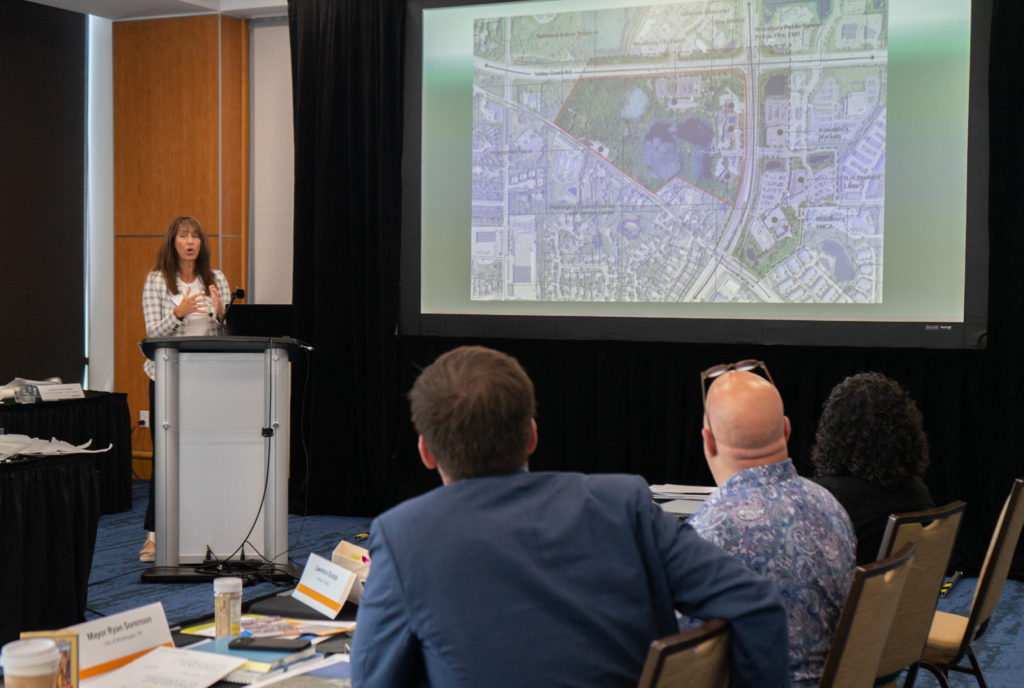My participation encouraged me, taught me, and gave me the contacts I needed to stop the throughway and then reallocate the money toward a redesign and revitalization effort that is now underway, saving our downtown core. But for MICD, I doubt we would have ended up saving the four city blocks that are now being rebuilt.
Mayor Lee Robinson (1988-1991); Tommy Olmstead (1992-1995); Jim Marshall (1996-2000); C. Jack Ellis (2000-2007); Robert Reichert (2007-2020)
1990 MICD 8, 1993 MICD 14, 1996 MICD 21, 2000 MICD Brownfields, 2001 MICD South, & 2009 MICD 45
Background
Macon is located 85 miles southeast of Atlanta near the geographic center of the state. Downtown Macon sits on a diagonal grid with wide streets leading up to the Ocmulgee River on the northeast. The area is served by two Interstate highways, I-75 and I-16. Recognizing the opportunity to capitalize on the city’s rich cultural and historic assets dated back to the early 19th century, five successive Macon mayors attended the Mayors’ Institute and brought projects that addressed different aspects of downtown revitalization.
Challenge
In a 1993 case study, former Mayor Olmstead spearheaded the revitalization effort by seeking recommendations from MICD’s Resource Team on how to build an attractive gateway off the Interstate into the central business district. Mayor Olmstead was also looking for strategies to coordinate projects at various stages in this area and find a way to integrate the river and Central City Park into the local urban fabric. He was particularly interested in adaptive reuse strategies for buildings and storefronts facing the new Georgia Music Hall of Fame on the east side of downtown. Confronted by myriad design issues on the proposed Civic Square in front of Macon City Hall, Olmstead’s successor, former Mayor Marshall, brought the project to the Institute in 1996. The space was problematic because three major thoroughfares—First and Poplar Streets and the historic Cotton Avenue—intersected at the site, making it unappealing and dangerous for cars and pedestrians alike. The project presented an opportunity to transform an otherwise desolate space at the heart of downtown into an active gathering spot for the community.
Four years later, former Mayor Ellis brought his first case study to the Institute, seeking design guidelines for brownfield redevelopment projects in the newly designated Downtown Industrial District. Mayor Ellis returned in the following year with another case study that focused on the implementation of a master plan for the downtown core. In the most recent case study, former Mayor Reichert was seeking design alternatives for Second Street realignment to create pedestrian-oriented, uniform lanes that run through downtown. The mayor also asked MICD’s design experts to weigh in on development options for vacant parcels on the west side of the Second Street corridor.
Impact
Few cities have sent their mayors to the Institute as frequently as Macon has over the last two decades. Not surprisingly, high participation rate and strong local leadership yield astounding results on the built environment of the city’s central business district. Reflecting on his experience at the Institute in 2009, Reichert explained, “You bring home a more polished product, so rather than an idea sketched down on the back of a napkin, you end up with something where experts have looked at it… so you can better sell it not only to your city council or to other local governments… you can also sell it to the ultimate decision-makers: the people.” Referring to his case study project, the Civic Square across city hall, Marshall added, “My participation encouraged me, taught me, and gave me the contacts I needed to stop the throughway and then reallocate the money toward a redesign and revitalization effort that is now underway, saving our downtown core. But for MICD, I doubt we would have ended up saving the four city blocks that are now being rebuilt.”



